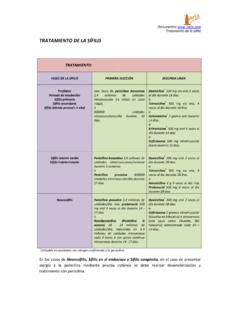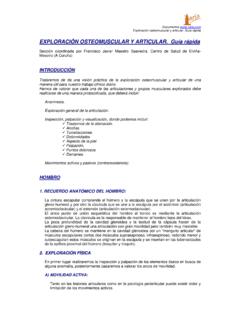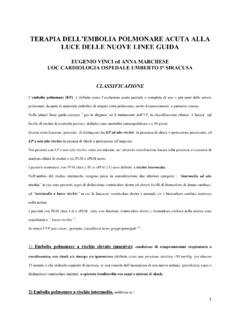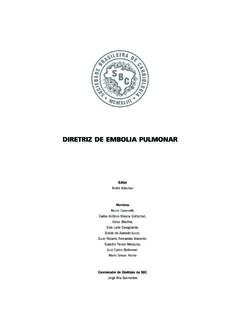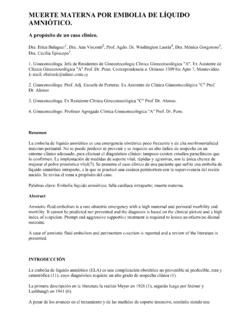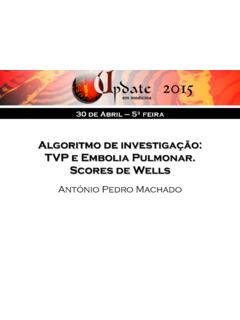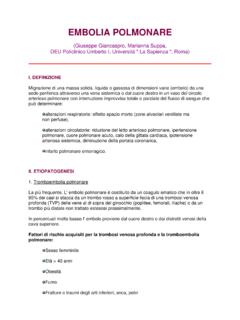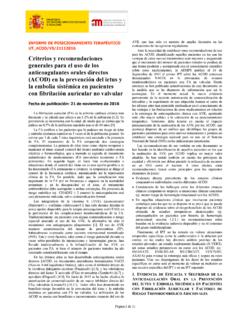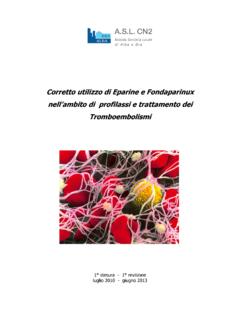Transcription of EVALUACIÓN DEL RIESGO DE ICTUS EN PACIENTE CON …
1 Documentos Evaluaci n del RIESGO de ICTUS en PACIENTE con fibrilaci n auricular EVALUACI N DEL RIESGO DE ICTUS EN PACIENTE CON FIBRILACI N. AURICULAR. ESCALA CHADS2. Actualizada Noviembre de 2012. Para su evaluaci n se utiliza la ESCALA CHADS2 que consta de los siguientes apartados: INSUFICIENCIA CARDIACA CONGESTIVA 1. HIPERTENSI N 1. EDAD 75 A OS 1. DIABETES MELLITUS 1. ICTUS PREVIO 2. SIENDO SI 1 PUNTO Y NO 0 PUNTOS (SALVO ICTUS PREVIO QUE SON 2 PUNTOS). El resultado, de 1 a 6 puntos, nos determina el tipo de RIESGO y porcentaje de RIESGO de presentar un accidente cerebro-vascular por a o. RIESGO DE ICTUS ANUAL (1). PUNTUACI N CHADS2 TIPO DE RIESGO PORCENTAJE DE 95% INTERVALO DE. RIESGO DE ICTUS CONFIANZA. 0 BAJO RIESGO 1,9 1,2-3,0. 1 RIESGO MODERADO 2,8 2,0-3,8. 2 RIESGO MODERADO 4,0 3,1-5,1. 3 ALTO RIESGO 5,9 4,6-7,3. 4 ALTO RIESGO 8,5 6,3-11,1. 5 ALTO RIESGO 12,5 8,2-17,5. 6 ALTO RIESGO 18,2 10,5-27,4. Se utiliza para determinar si el PACIENTE requiere o no tratamiento con anticoagulante o antiagregante.
2 En la siguiente tabla incluimos las recomendaciones de tratamiento seg n la puntuaci n del CHADS2 en pacientes con fibrilaci n auricular sin alteraciones vasculares (2). TRATAMIENTO. VALOR DEL CHADS2 RIESGO RECOMENDACIONES. ANTITROMB TICO. 0 Bajo cido acetil salic lico cido acetil salic lico 75-325 mg/d a Anticoagulantes orales (INR de 2 a 3), o cido Bajo a cido acetil salic lico o 1 acetil salic lico 75-325mg diario (Dependiendo Moderado Anticoagulantes orales de factores como la preferencia PACIENTE ). Moderado, 2 o m s Anticoagulantes Anticoagulantes orales con INR entre 2-3. alto o muy alto Nuevas evidencias: Nuevas gu as (9 Edici n) de anticoagulaci n de la American College of Chest Physicians (CHEST): Antithrombotic Therapy for Atrial Fibrillation. Antithrombotic Therapy and Prevention of Thrombosis, 9th ed: American College of Chest Physicians Evidence-Based Clinical Practice Guidelines. John J. You, MD et al. CHEST. 2012; 141(2)(Suppl):e531S e575S.
3 9 Se contin a considerando el score del CHADS2. 9 Para CHADS2 de cero no se recomienda tratamiento antitromb tico. 9 Pacientes con CHADS2 = 1 o m s se recomienda la anticoagulaci n oral. 9 En pacientes con CHADS2 mayor a 1 sin enfermedad valvular ni enfermedad coronaria se recomienda anticoagulaci n oral con dabigatr n 150 mg dos veces por d a en lugar de anticoagulaci n con dicumar nicos. 1. - Gage BF, Waterman AD, Shannon W, Boechler M, Rich MW, Radford MJ (2001). "Validation of clinical classification schemes for predicting stroke: results from the National Registry of Atrial Fibrillation". JAMA 2001; 285 (22): 2864 70. Eckman MH, Singer DE, Rosand J, Greenberg SM. Moving the tipping point: the decision to anticoagulate patients with atrial fibrillation. Circ Cardiovasc Qual Outcomes. 2011 Jan 1;4(1):14-21. Otros art culos relacionados: Gage BF, van Walraven C,Pearce L, et al. Selecting patients with atrial fibrillation for anticoagulation: stroke risk stratification in patients taking aspirin.
4 Circulation 2004, 110 (16): 2287 92. Go AS, Hylek EM, Chang Y, Phillips KA, Henault LE, Capra AM, Jensvold NG, Selby JV, Singer DE. Anticoagulation therapy for stroke prevention in atrial fibrillation: how well do randomized trials translate into clinical practice? JAMA. 2003; Nov 26; 290(20):2685-92.
